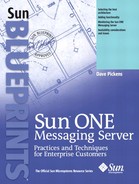Chapter 3. Messaging Architectures
This chapter describes the architectures of some of the more common configurations and explains that there are almost infinite combinations. It outlines the pros and cons of each architecture to provide you with information to determine which architectures meet your enterprise messaging requirements. Chapter 10, “Security,” on page 153,” addresses security in detail, but a secure architecture is discussed in this chapter to indicate the use of firewalls in multiple layers, that is, a demilitarized zone (DMZ) as not all messaging systems actually are behind firewalls.
This chapter covers the following topics:
Directory
MTA
Mailstore
Proxy Servers
Simple Single-Layer Architecture
Simple—Alternative Architecture
Typical Architecture
Secure—Basic Architecture
High Availability—Failover Architecture
Often there is more than one method of doing things. Designing and installing a messaging system is no different. Depending upon your organization's specific goals, skills, and networking environment, one architecture may be more relevant than another.
Generally, the architectures can be organized into several categories or combinations of categories:
Simple Single Layer
Multitiered
Secure
Highly available
To help you understand more about messaging architecture, this chapter reviews some of the basic parts of the messaging system first.
Four basic parts of a messaging system are important or can be sized.
Directory
Gateway, also called message transfer agent (MTA)
Mail server, also called mailstore
Proxy server
